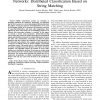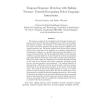102 search results - page 9 / 21 » Undoing the effects of action sequences |
TITB
2010
13 years 2 months ago
2010
Mobile sensor-based systems are emerging as promising platforms for healthcare monitoring. An important goal of these systems is to extract physiological information about the subj...
AIPS
2008
13 years 9 months ago
2008
Flexible general purpose robots need to tailor their visual processing to their task, on the fly. We propose a new approach to this within a planning framework, where the goal is ...
DAC
2009
ACM
14 years 8 months ago
2009
ACM
For a number of years, dataflow concepts have provided designers of digital signal processing systems with environments capable of expressing high-level software architectures as ...
CONNECTION
2006
13 years 7 months ago
2006
We present an approach for recognition and clustering of spatio temporal patterns based on networks of spiking neurons with active dendrites and dynamic synapses. We introduce a n...
SIGGRAPH
2010
ACM
13 years 12 months ago
2010
ACM
This paper presents a video-based motion modeling technique for generating physically realistic human motion from monocular video sequences. We formulate the video-based motion mo...


